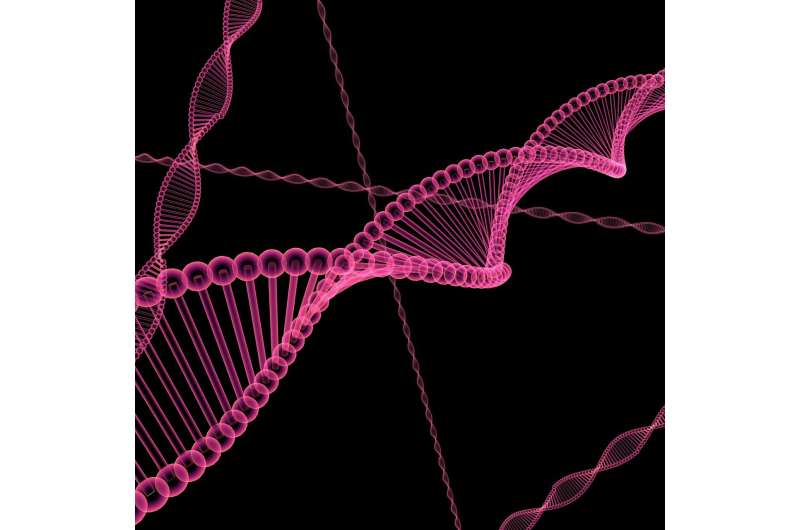This article has been reviewed according to Science X's editorial process and policies. Editors have highlighted the following attributes while ensuring the content's credibility:
fact-checked
reputable news agency
proofread
More than 260,000 Penn Medicine patients have agreed to share their DNA for research

Any changes in your medications or allergies? Check. New health issues since your last visit? Check.
And would you like to contribute a blood and DNA sample for a massive research project?
That last question is now part of the electronic check-in process for patients at Penn Medicine clinics and hospitals, and it already is yielding promising clues in the study of disease.
More than 260,000 people have signed up to participate in the project, called Penn Medicine BioBank, agreeing to have their samples stored in secure freezers set to negative 80 degrees Celsius. By cross-referencing participants' DNA with their electronic health records, researchers have discovered genetic variants related to heart disease, hearing loss, diabetes, glaucoma, and muscular dystrophy, among other conditions.
The project began more than a decade ago and has doubled in size since the invitation to participate was incorporated into the electronic check-in process in 2020, making Penn's one of the largest of a dozen similar efforts in the United States.
Rather than collect DNA from patients with a specific condition, the idea is to obtain samples from a wide cross-section of humanity, enabling researchers to tease out the genetic causes for a range of diseases, said geneticist Marylyn Ritchie, co-director of Penn's program.
"We are disease-agnostic," she said.
That concept—casting a wide net for clues to a range of diseases—is common at most biobanks, which have become an increasingly powerful research tool since the completion of the Human Genome Project in 2003.
Unlike most other biobanks here and abroad, Penn's repository boasts a high percentage of samples from people of color. Nearly one-third are of non-European ancestry, including 17% who identify as African American—a group often underrepresented in clinical trials and other research.
The inclusion is crucial, as the rates of disease and the effectiveness of treatments can vary greatly in people of different racial and ethnic ancestry, Ritchie said.
"That is a huge strength," she said. "The participants that are enrolling reflect our patient population in terms of biogeographic diversity."
A case in point is a 2019 study of a type of heart disease, which relied on patient samples from the Penn BioBank and a similar effort at the Geisinger health system in Danville, Pennsylvania.
Researchers found a genetic variant in white patients that was associated with a higher risk of dilated cardiomyopathy, a condition in which the heart's main pumping chamber becomes enlarged and weak. But in people of African ancestry, the same genetic variant was not connected to a higher risk of that disease, said Penn cardiologist Dan Rader, one of the authors.
"We still actually to this day don't fully understand it," he said.
More research is needed, but Rader expects the findings will guide treatment of the disease.
The Penn Medicine BioBank occupies 11,400 square feet in Penn's Clinical Healthcare Technology building on Civic Center Boulevard. It contains 97 freezers so far, with enough room for twice that many.
The vials of blood inside the boxy white units have been stripped of any patient identifiers such as names, addresses, or birth dates. DNA is extracted from the cells contained in those blood samples, accessible to researchers only on secure computers managed by Penn Medicine.
But the power of biobanks goes well beyond DNA, said Rader, who codirects the repository at Penn along with Ritchie. For some diseases, researchers can learn even more from proteins and other biomarkers found in the blood, he said.
"If someone was recruited years ago, and they were healthy at the time and subsequently developed a type of cancer or Alzheimer's, we can pull samples out of the freezer and measure things," he said. "We can use that to develop new biomarkers that are predictive of developing those diseases in the future."
Launched in 2008, Penn's BioBank enrolled 71,000 participants in its first decade. Staffers approached patients in clinics and invited them to sign up on a clipboard, a laborious, time-consuming process that fell short of reaching all who might've been interested, Ritchie said.
But in 2020, when the sign-up process was incorporated into the electronic check-in system for appointments, participation more than doubled within two years. Among the first 360,000 people who learned of the program that way, 54% agreed to participate, 20% said no, and the remaining 26% opted to defer their decision.
When people sign up to participate during an appointment check-in, they don't have their blood drawn for the bank until a subsequent visit. Of the 260,000 participants so far, 80,000 have come back to have their samples collected.
The number of participants is expected to grow even more, as the sign-ups are not yet offered in some of Penn's suburban clinics.
Ritchie, Rader, and their colleagues say their journey to new discoveries has only just begun.
2023 The Philadelphia Inquirer, LLC. Distributed by Tribune Content Agency, LLC.


















